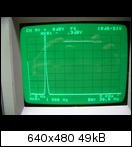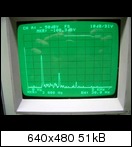Most of them still work, but also most of them have some minor problems with attenuators, switches and potentiometers.
I would say: A working unit for 250 to 300 Euro, and a real good one up to 400 Euro.
Remark: This unit is absolutely useless for (direct) audio measurements without a good notch filter because of the limited danymic range.
This one is useful:
uk.geocities.com/cyrilb2@btinternet.com/...5.../capsound2.pdf
I would say: A working unit for 250 to 300 Euro, and a real good one up to 400 Euro.
Remark: This unit is absolutely useless for (direct) audio measurements without a good notch filter because of the limited danymic range.
This one is useful:
uk.geocities.com/cyrilb2@btinternet.com/...5.../capsound2.pdf
1. The unit (3582a) has a buitlt-in generator and offers only limited dynamics.
It´s just a noise source (also "nur" ein Rauschgenerator).
2. Your add-on filters the generator signal and allows to amplify frequency dependent the different distortion products?
The internal noise source is not usable for LF distortion measurement. I assume that you want to use the 3582 for audio measurement. The unit is good to measure many things like noise on DC voltages or phase measurements, but not for harmonic distortion in high quality audio device.
Therefore you need a very(!) good sine generator and a notch filter. A simple notch filter is mostly designed for a fixed frequency. (for example 1 KHz) It rejects the fundamental (1 KHz) while all the harmonics (and lower frequencies) can pass without attenuation. So the Dynamic rises.
You can also use the build in filter from a classic distortion bridge with "monitor output".
Thanks Hardi, I got the point. I started reading your articles (link), I know now, that I have to built the high quality sine generator, and use additionally the notch filter to enhance dynamics of th HP... Will first read the arcticles, get an understandig and then ask further stupid questions... ;-)
So, I read the articles 1/2 from Cyril Bateman. Fantastic piece of work. I now need to build the Sine generator and the notch filter. In another thread I read, that Mr. Bateman sold pcbs and a cd with a detailed description. But: On his (sometimes unavailable!) website I found no possibility to order pcb / parts.
How did you manage to build your own instrumentation??? Any source for pcbs / parts???
Thanks, Dirk
How did you manage to build your own instrumentation??? Any source for pcbs / parts???
Thanks, Dirk
Last edited:
How did you manage to build your own instrumentation??? Any source for pcbs / parts???
I never built one of these.
I still have a 3582A (and some other SA), but i do not measure distortion with it.
How do you perform spectral distortion analysis?
Audio Precision SYS222A. Sometimes i use a HP3561A with a simple 1 KHz/50 dB Notchfilter, but AP is much more"comfortable" and better.
What, if not this task, you use your 3582 for???
I own my 3582A for over 15 Years.....Now it´s just "a part of my collection".
PS: I am also interested in a pcb set....So if you can manage to find a source...
An example for measuring THD with the 3582A:
Signal source is an HP339A generator. 1KHz /1V.

Nothing to see on a 3582A.
Now 1KHz/1V through a simple double-T notchfilter. Attenuation depends extremly on the 1KHz accuracy. Using the 339 vernier allows up to 80 db (for a minute or so), because of the "cold" generator drift.
It´s better to give all parts (339, notch and 3582) 30 min. to warm up.

Second Harmonic is about -108 dB (AP measures -106,8 dB).
Signal source is an HP339A generator. 1KHz /1V.

Nothing to see on a 3582A.
Now 1KHz/1V through a simple double-T notchfilter. Attenuation depends extremly on the 1KHz accuracy. Using the 339 vernier allows up to 80 db (for a minute or so), because of the "cold" generator drift.
It´s better to give all parts (339, notch and 3582) 30 min. to warm up.

Second Harmonic is about -108 dB (AP measures -106,8 dB).
Last edited:
It´s an active one with feedback. Q is set to "1", thereby the second Harmonic (2 KHz) is not attenuated.
Something like this will work:
http://www.mikrocontroller.net/attachment/26042/notch.png
Something like this will work:
http://www.mikrocontroller.net/attachment/26042/notch.png
The HP 3582A spectrum analyzer is a CRT equipped version of the 3581A wave analyzer, it has a 90dB dynamic range (0.004% THD noise floor) and is calibrated to an 80dB (0.01% THD) range.
I have two 3581As, and wish I had a 3582A, and have yet to find a digital instrument, I can afford, that is as competent.
Here's the 0.0Hz to 20kHz spectrum of a 1.0kHz signal from a Kikusui ORC-11 low-distortion (0.0019%) generator, captured from the X and Y outputs of a 3581A via my Lecroy WaveJet 322...

The 3581/2 built-in tracking generator allows complete network analysis and provides a well defined sine wave (<0.2% THD if properly calibrated) for response plotting from 10Hz to 50kHz.
These things are getting pretty old, but they are nonetheless still quite useful...
I have two 3581As, and wish I had a 3582A, and have yet to find a digital instrument, I can afford, that is as competent.
Here's the 0.0Hz to 20kHz spectrum of a 1.0kHz signal from a Kikusui ORC-11 low-distortion (0.0019%) generator, captured from the X and Y outputs of a 3581A via my Lecroy WaveJet 322...

The 3581/2 built-in tracking generator allows complete network analysis and provides a well defined sine wave (<0.2% THD if properly calibrated) for response plotting from 10Hz to 50kHz.
These things are getting pretty old, but they are nonetheless still quite useful...
- Status
- This old topic is closed. If you want to reopen this topic, contact a moderator using the "Report Post" button.
- Home
- Design & Build
- Equipment & Tools
- HP 3582a spectrumnalyzer